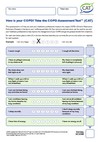CPT2: COPD Flashcards
(34 cards)
What is COPD?
Airflow limitation due to airway and / or alveolar abnormalities
What is the pathophysiology of COPD?
2 Main processes involved: Chronic bronchitis and emphysema:
Chronic bronchitis
Normally particles/dust/toxins in the airway become tapped in sputum which is sweeped away by cilia. However in COPD due to extensive exposure and inhalation of toxins these cilia become impaired and damaged. This leads to soutm and particles not being cleared as effectively therefore clogginf the airways and making it difficult to breathe, as well as, a perfect enviroment for infection.
There is also an increase in inflammatory cells which cause bronchoconstriction of the airways, narrowing them and making it more difficult to breathe. This can also lead to gas trapping.
Emphysema
Extensive toxin inhalation can also directly affect the alveoli. It causes damage and thinning of the alveloar walls eventually leading to them dissolving all together. This leads to enlargement of distal gas exchange spaces. Gas exchange is therefore less effective and gas trapping can also occur. The patient can have hypoxemia (low O2 in blood) or hypercapnia (high CO2 in blood)
What symptoms to patients with COPD present with?
- Breathlessness which has had a gradual onset
- Cough
- Sputum production
- Wheeze
- Frequent winter bronchitis/ chest infections
What does it mean by COPD is a hetrogenous condition/ multifactorial
Associated with significant, co-existing medical conditions e.g. CVS, osteoporosis, anxiety, depression. These all negatively impact the mortality and morbidity in patients with COPD
What is COPD caused by?
Epidemiology?
Treatment goals?
- Long term exposure to toxins
- Tobacco smoke most common
- Common Condition
- 4th leading cause of death
- morbidity high
- Preventable
- Treatable
- Symptom Management
- Reduce Risk
What does assessment involve?
What is used?
2 important factors:
- Symptoms
- Risk of exacerbation
These must be combined for the purpose of improving management of COPD.
Gold Criteria used to assess COPD and places patients in 4 categoties based on those 3 important factors
What assessment tools are used?
- mMRC
- FEV1/FVC and FEV1
- CAT assessment
Describe mMRC

Describe the use of CAT

Describe the use of FEV1/FVC

Which is more severe?

Neither - both severe in own way and require different treatments
Goals of treatment for COPD?

What are low cost treatment options which can be extremely beneifical nad effective?
Vaccinations
Pulmonary rehabilitation
Smoking cessation
Describe vaccinations
- •Pneumococcal vaccination and an annual influenza vaccine should be offered to all patients with COPD
- Helps reduced respiratory infections therefore exacetbations
- Cheap, easy, effective
Describe the use of pulmonary rehabilitation
•All COPD patients appear to benefit from rehabilitation and maintenance of physical activity, improving their exercise tolerance and experiencing decreased dyspnoea and fatigue
Describe the use of smoking cessation
•Smoking cessation is the key intervention for all COPD patients who continue to smoke
What are the main pharmacological treatment options for COPD?
Bronchodilators
CCS
What are bronchodilators broken up into?
What is each short/long acting used for?
Give some example of drugs used
Two main classes of bronchodilators:
- B2-agonsits
- SABA/LABA
- Anti-musclaranics
- SAMA/LAMA
Short acting are used for relief/rescue when there is an acute exacerbation of symptoms. Examples include Salbutamol (SABA) or terbutaline (SABA)
Long acting preperations are used to prevent symptoms of breathlessness. Examples include Formoterol (LABA), Vilanterol (LABA), tiotropium (LABA), Glycopyttonium (LAMA), Indacaterol (LABA). LA preperations are more effective and convient for maintance and can also reduce risk of exacerbations
What is the mechanism of action of SABA or LABAs
Stimulate B2 receptors on airway smooth muscle. This has 2 effects on the airway:
- Bronchodilation
- Increases cAMP which antagonises bronchoconstriction
This therefore opens up the airway an aims to stop the closing of the airway relieving breathlessness
Mechanism of action of LAMA/SAMA
Bind to M3 receptors and block them therefore ACH mediated bronchoconstriction and mucus secretion is inhibited. This helps to produce wider airways and prevent mucus secretion clogging the airways
MAin effects of bronchodilators
- Overall alters airway smooth muslce tone and widens the airways improving expiratory flow
- Reduces air trapping and imroves lung emptying therefore improves symptoms and exercise capacity
- Improves skeletal muscle function and mucocilary clearance

What is an exacerbation?
An exacerbatio is an event in the natural course of the disease characterised by a changed in a patients baseline symptoms - dysponea, cough and/or sputum that is beyond the normal day-to-day variation and is acute in onset and may cause a change in normal medication in a patient with underlying COPD
What are the conseuquences of an exacerbation
Increased inflammation:
- Increased bronchonstriction
- increased odema
- increased mucus
- airflow limited
- hyperinflation
- Systemic inflammation

What do ICS do?
Benefits?
They reduce inflammation
- Reduced exacerbatin
- Improved breathlessness
- Improve QOL
- Reduce hospital admissions
- Preserve lung function
- Potentially reduce mortality
When used in combo with a LABA dramatically decrease exacerbation risk. Also reduce hospital admissions, improve QOL and reduce rate of decline




